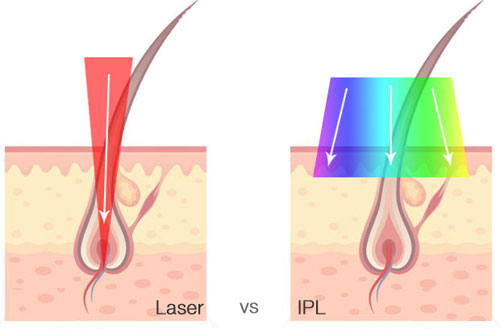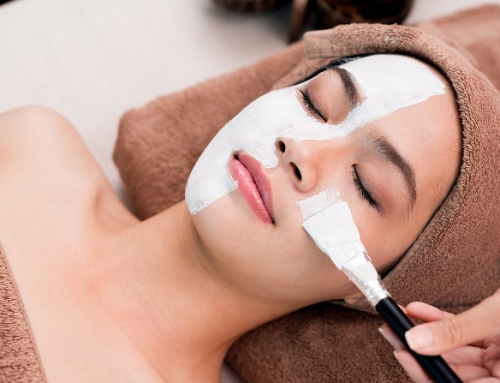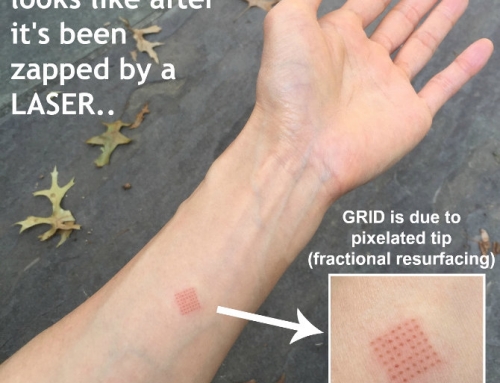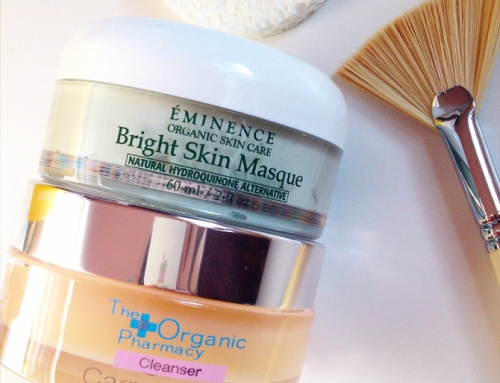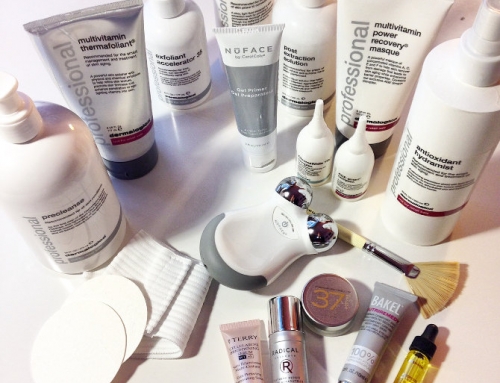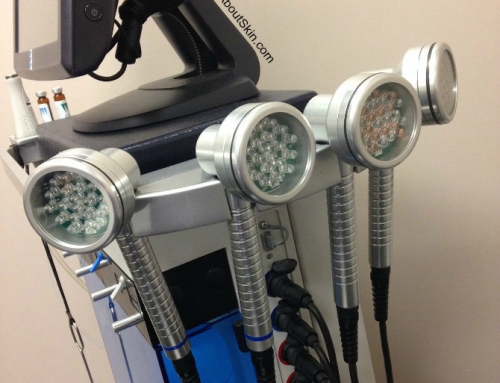Today’s post is a deeper look at Intense Pulsed Light (IPL), a topic that I introduced earlier this week.
If you haven’t read that post yet, it would be helpful to read it before you read this. It explains what IPL and laser light do to skin and how they’re different: IPL vs Laser – A Guide To Understanding Light Treatments.
What Problems Does IPL Treat?
Intense Pulsed Light (abbreviated IPL) is a type of light treatment that is non-ablative. This means that the light does NOT remove the superficial layers of skin.
Some lasers, on the other hand, are ablative (remove the outer layers of skin, which is known as resurfacing). Lasers will be covered in the next post.
IPL light works by channeling heat at color targets in different layers of the skin. And because it can reach different depths of skin, it can treat a variety of skin conditions.
The major ones are pigmentation, vascular conditions, hair removal, and to a lesser extent collagen production.
PIGMENTATION
Pigmentation means the coloring of skin. You are born with a certain pigmentation (your natural skin color). But you may have spots or sections of your skin with darker color or lighter color.
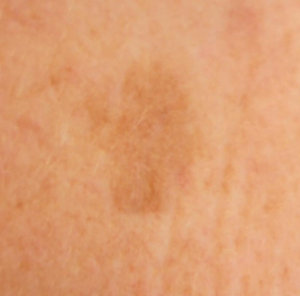 IPL (and laser) are used to treat hyperpigmentation, which is when you have an excess of pigmentation. In other words, when something is darker than the surrounding skin.
IPL (and laser) are used to treat hyperpigmentation, which is when you have an excess of pigmentation. In other words, when something is darker than the surrounding skin.
IPL cannot be used to treat hypopigmentation (when you have a spot that is lighter than the surrounding skin).
Here are the types of hyperpigmentation that can be treated by IPL:
- sun spots (brown spots due to UV damage)
- brown discolorations
- acne scars
- melasma
- birthmarks
- actinic keratosis
Who Is A Good Candidate?
Lighter skin tones (Fitzpatrick Skin Types 1-3).
The light is attracted to a colored target in skin (say a brown spot). In fact, the darker the spot, the better.
IPL is ideal when there is more contrast between the base skin color and the target color. So for example, a dark spot on fair skin will be easier to treat because there is a greater color contrast between the skin and the spot.
Who Is NOT A Good Candidate?
Darker skin tones (Fitzpatrick Skin Types 4-6) are not good candidates for IPL (or laser). But IPL can still be used with discretion.
The problem for darker skin tones is that the skin surrounding the problem area will absorb some of the light, simply because there is more pigment in skin to attract that light. This surrounding skin can be injured. Also, the light may leave the skin darker or lighter than it was before.
The skin professional will determine your Fitzpatrick Skin Type to assess whether IPL for treating pigmentation is right for you. An accurate determination is crucial for a successful outcome. This goes back to what I said in my previous post. It’s very important you choose a professional with a lot of experience.
Today, we are more racially diverse than ever. Some of us are multi-racial, with a mixture of ethnicities from our parents, grandparents, and further back. Let’s say, for example, we have one black parent and one white parent, but we look more white. Even if our skin looks fair, we may respond to light as if we had a darker skin tone (a higher numbered Fitzpatrick type).
An experienced skin professional will take a thorough skin history and be able to identify these kinds of risks, to avoid any potential chance of injury.
REDNESS & VASCULAR LESIONS
Vascular is defined as blood-related. A vascular lesion is a problem due to a disruption of the blood vessels. Vascular lesions are red or purple in color.
 IPL can treat these types of blood-related issues:
IPL can treat these types of blood-related issues:
- rosacea
- telangiectasia
- spider veins
- varicose veins
- port wine stains
- bruises
- and others
Some of these issues may be better treated by laser, depending on the size of the area to be treated, and the depth of the lesion.
HAIR REMOVAL (REDUCTION)
The way you get rid of hair is by destroying the pigment in the hair follicle. The hair follicle is the shaft where a strand of hair is anchored.
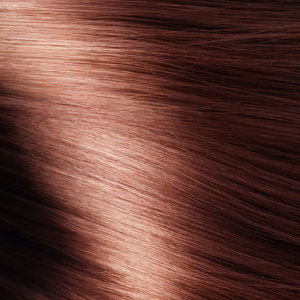 The light from IPL (or laser) is attracted to the color of the hair (its pigment).
The light from IPL (or laser) is attracted to the color of the hair (its pigment).
To destroy the pigment, you need focused heat in the hair follicles. A laser is more effective at delivering focused heat than IPL because it produces a narrow, concentrated beam of light.
So while IPL and laser can both be used to reduce hair growth, a laser is more effective at it. But it comes with considerably more pain and takes more time.
The best candidates for hair removal is darker hair. Light colored hair, such as blonde hair, as well as gray/white hair cannot be treated since the hairs lack the pigment to attract light.
Just as it is so for pigmented spots, the greater the contrast between the base skin color and the hair color, the better the results. So, dark hair on fair skin can be removed most successfully.
COLLAGEN PRODUCTION
Another use for IPL light is reducing fine lines and wrinkles and skin tightening. This application is sometimes marketed as “skin rejuvenation,” a vague term that can mean anything today.
The heat from the light stimulates collagen production (by stimulating fibroblast activity), but this does not yield immediate, visible results. You won’t see any “wow” effect after a single treatment. Any changes will be gradual and require a series of treatments.
In general, longer wavelengths and ablative lasers (to be discussed in the next post) are more effective at treating wrinkles.
When Is Laser Better Than IPL?
Laser is best for skin resurfacing (to be covered in the next post), tattoo removal, hair removal of thick, coarse, stubborn hair, dense vascular lesions, and pigmentation that is found deep inside skin (dermal pigment).
IPL and lasers overlap quite a bit in terms of what they conditions can treat. For instance, they both can treat pigmentation, vascular lesions, hair growth, and loss of collagen.
Choosing one over the other is done on a case by case basis. Much of that decision is largely dependent on your skin type – the color of it, how likely you scar, and how easily you pigment. It also depends on your timeline (how fast you want to see results) and your tolerance for pain or downtime.
IPL Machines
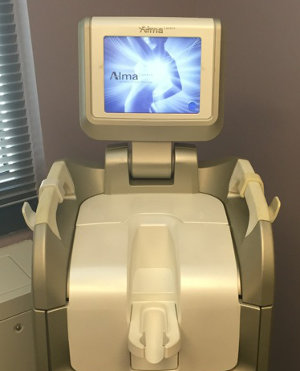 There are a variety of IPL machines and tools. The modular systems are equipped with multiple modalities – for example, IPL and laser in one machine.
There are a variety of IPL machines and tools. The modular systems are equipped with multiple modalities – for example, IPL and laser in one machine.
And for each modality, there are different wavelength options. Changing the wavelength is done by changing the handpiece. Each handpiece represents a different color (wavelength).
By swapping handpieces, the skin professional can give you a treatment with different wavelengths in the same session.
Stay tuned for a deeper look at lasers in the next post on this topic.
Related Posts:
- IPL vs Laser – A Guide To Understanding Light Treatments
- Laser Skin Resurfacing
- What’s Your Fitzpatrick Skin Type?
- LED Light Therapy
Want articles & posts delivered straight to your inbox? Sign up for the weekly newsletter here.


